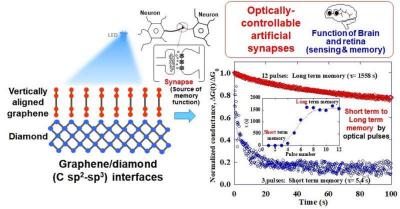Researchers from Nagoya University in Japan have designed highly efficient computing devices using graphene-diamond junctions that mimic some of the human brain's functions.

A phenomenon crucial for memory and learning is "synaptic plasticity," the ability of synapses (neuronal links) to adapt in response to increased or decreased activity. Scientists have tried to recreate a similar effect using transistors and "memristors" (electronic memory devices whose resistance can be stored). Recently developed light-controlled memristors, or "photomemristors," can both detect light and provide non-volatile memory, similar to human visual perception and memory. These excellent properties have opened the door to new materials that can act as artificial optoelectronic synapses.
Dr. Ueda explains, "Our brains are well-equipped to sieve through the information available and store what's important. We tried something similar with our VG-diamond arrays, which emulate the human brain when exposed to optical stimuli." He adds, "This study was triggered due to a discovery in 2016, when we found a large optically induced conductivity change in graphene-diamond junctions." Apart from EPSC, STM, and LTM, the junctions also show a paired pulse facilitation of 300%âan increase in postsynaptic current when closely preceded by a prior synapse.
The VG-diamond arrays underwent redox reactions induced by fluorescent light and blue LEDs under a bias voltage. The researchers attributed this to the presence of differently hybridized carbons of graphene and diamond at the junction interface, which led to the migration of ions in response to the light and in turn allowed the junctions to perform photo-sensing and photo-controllable functions similar to those performed by the brain and retina. In addition, the VG-diamond arrays surpassed the performance of conventional rare-metal-based photosensitive materials in terms of photosensitivity and structural simplicity.
Dr. Ueda says, "Our study provides a better understanding of the working mechanism behind the artificial optoelectronic synaptic behaviors, paving the way for optically controllable brain-mimicking computers better information-processing capabilities than existing computers."

